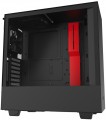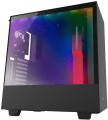3.5" bays
The number of internal 3.5" form factor bays provided in the design of the case. Such bays, in accordance with the name, are intended for internal components, mainly hard drives and some SSD modules; to access them, the case must be disassembled.
Theoretically, the number of bays corresponds to the maximum number of drives that can be installed in the chassis. However, in fact, the best option is to install drives through a single slot to ensure efficient cooling. Accordingly, it is best to select a case in such a way that the number of internal 3.5" bays is twice the expected number of hard drives.
internal 2.5" compartments
The number
of internal 2.5" bays provided in the case design.
Such bays are mainly used for installing internal hard drives and SSD modules; The 2.5" form factor was originally created as "laptop" form factor, but recently it has been increasingly used in components for full-size PCs. At the same time, when evaluating the number of these bays, note that drives are recommended to be installed through a slot; so in Ideally, the number of bays should be twice the planned number of drives.
Also note that some cases use combined bays: initially they have a size of 3.5", but if desired, they can be converted to 2.5". These bays count towards both 3.5-inch and 2.5-inch slots. In fact, this means that the total number of available slots is not always equal to the sum of the number of both. For example, a case with 10 3.5" bays and 6 2.5" bays can have 4 combined bays, and the total number of slots in this case will not be 16, but only 12.
Expansion slots
The number of slots for expansion cards located on the rear panel of the case.
The expansion card itself (graphics card, sound card, TV tuner, etc.) is installed in a slot on the motherboard, and an external panel of such a card with inputs and outputs is attached to the hole on the back of the case. The more holes are provided in the case, the more expansion cards can be installed in it. Note that some boards can occupy two or even three holes at once; this is especially common in powerful video cards. On the other hand, you have to pay attention to the number of holes mainly if you are building a powerful high-performance system. For an ordinary household PC, in most cases, one opening is enough for a graphics card; and in many configurations, the openings on the rear panel are not used at all.
Integrated hub
A hub in a computer case for connecting fan and backlight control systems. Depending on the implementation, the
complete hub can be installed inside the case or placed on its outer panel. Often, a remote control with an infrared transmitter is attached to the hub to control the "turntables" and decorative lighting of the "insides" of the case.
USB 3.2 gen1
The number of native USB 3.2 gen1 connectors (previously labeled as USB 3.1 gen1 and
USB 3.0) provided in the case.
Such connectors are usually located on the front side (for more details, see "Location"). They are most convenient for peripherals that need to be connected and disconnected often — for example, "flash drives" (for permanently connected devices, it is more convenient to use the motherboard connectors displayed on the rear panel). Specifically, the USB 3.2 gen1 standard has replaced the USB 2.0 described above, it provides 10 times the data transfer rate (up to 4.8 Gbps) and higher power supply, while USB 2.0 peripherals can also be connected to such connectors .
It is worth remembering that for normal operation of ports, their number and version must correspond to the capabilities of the motherboard.
USB type C 3.2 gen2
Number of native
USB-C 3.2 gen2(previously USB-C 3.1 gen2 and USB-C 3.1) connectors provided in the chassis.
Such connectors are usually located on the front side (for more details, see "Location"). They are most convenient for peripherals that need to be connected and disconnected often — for example, "flash drives" (for permanently connected devices, it is more convenient to use motherboard connectors that are displayed on the rear panel) . Specifically,
USB-C is a relatively new type of USB connector — smaller than classic USB and double-sided design. The use of such a connector may be different, depending on the features of the motherboard: in particular, it can also be used as a Thunderbolt v3 port, and the 3.2 gen2 connection interface is characterized by a bandwidth of up to 10 Gbps.
Front panel
-
Lattice. The grille on the front panel of the case often looks good and allows you to better supply the cooling system fans with more outside air. Decorative lighting is often placed behind the perforated panel, which improves the appearance of the case.
-
Blank. The competitive advantages of cases with a blank front panel are improved noise insulation and effective protection of the internal space of the computer from dust.
-
Glass. The veil of mystery of what is happening inside the computer system unit is lifted by cases with a glass front panel. Tempered glass as a “facade” material is used both in the form of a solid window and in the form of a glass grille with RGB backlighting. And in combination with the glass side window, it turns the body into
an “aquarium”.

